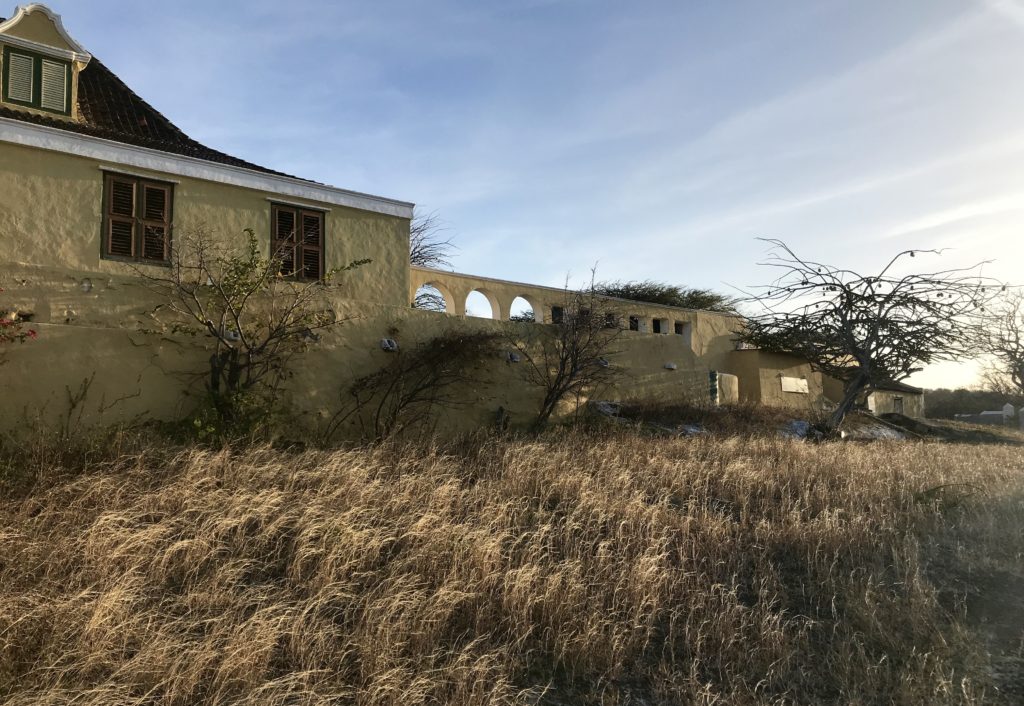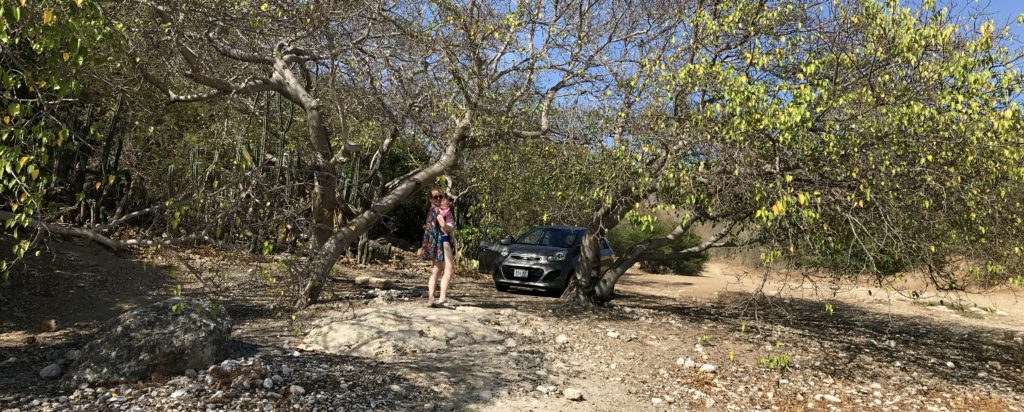Landhuis San Juan in Curacao is a great place to get off the beaten path. It combines the atmospheric ruins of an old plantation house with dirt roads and four undeveloped beaches.
The History of Curacao’s Plantations
Colonial Curacao
In the former Dutch colonies, a “landhuis” was roughly the equivalent of a plantation house in the American south. Often these were large country estates owned by elite families and surrounded by agricultural outbuildings and slave quarters. These great houses were typically built on high ground and used smoke signals to relay messages to each other. During the colonial period, these plantation estates dominated the countryside of Curacao.

Due to the poor soil and limited water in Curacao, these estates were far from prosperous and relied on slave labor to carry out the backbreaking work needed to eke a profit from the land. When slavery was abolished on the island in 1863, many of the former slaves initially found themselves tied to the land and their former masters as sharecroppers. However, as time passed other economic opportunities arose and the estates were largely abandoned. Today, Curacao is dotted with these landhuis buildings. Some have been repurposed and restored while others have fallen into ruin.
Landhuis San Juan
The Landhuis San Juan appears to have been founded in 1662 in what was, for Curacao, a relatively fertile valley. It once produced maize, sugarcane, cotton and indigo. However, like the other plantations on the island, it is no longer an operational farm. Grass and shrubbery grow in its feral fields. While the main house itself is largely intact and apparently still contains furniture, it is not inhabited and is closed to the public. The clean look of the place is due to a fresh paint job that it received when it was used as one of the primary filming locations for the 2013 film Tula: The Revolt starring Danny Glover. The film, by the way, is based on a nearly successful slave revolt and is worth a watch.

According to our Airbnb host, the family members that own the estate have long been at odds with each other over how to handle the property. It surrounds four beautiful beaches and comes with significant acreage, but land use restrictions make developing the area difficult. As a result, the family has limited themselves to monetizing the estate by collecting a fee from anyone who wants to drive through it in order to access the beaches.
The Beaches of San Juan
The main draw of the San Juan area of Curacao are the beautiful, undeveloped beaches that dot its coast. Although many sources only refer to three beaches, there are four in total. From west to east these include a small cove potentially called “Chiki,” Manzaliña, Shon Mosa, and Largo. The first three have sand, while Largo is made up entirely of dead coral.
Playa Manzaliña
Being gingers with a three month old baby in tow, we asked which beach would be best for afternoon shade and were directed to either of the first two. I randomly picked Manzaliña which ended up being the largest of the sand beaches. There are trees near the parking area that provide some shade, but you should not sit under them as they are poisonous Manzaliña trees. Apparently, not only is the apple-like fruit from the tree poisonous, but rain water dripping from the leaves has been known to cause some people to break out in rashes. Luckily, to the far right of beach there was a cliff and small cave that provided excellent shade. We ended up sharing the area with a few groups of Dutch nudists. While nudity is prohibited on all of the island’s beaches, the remote location apparently makes this beach an appealing place to bend the rules.

Parking under the poisonous Manzaliña trees 
Shade on Playa Manzaliña
Playa Largo

After a couple hours at Manzaliña and a foray into nude snorkeling, we hopped back in the car to explore Playa Largo at the far end of the property. As I mentioned before, Playa Largo is composed of rough, dead coral. It was really pretty but not a place to linger for long. It was also the riskiest place that I drove our little rental car since the last part of the drive goes from a dirt road to a loose, dead coral road.
Getting to Landhuis San Juan

If you want to visit San Juan while in Curacao, the entrance to the plantation is located on Weg Nar Westpunt, approximately 30 KM from the capital. The turnoff is well marked. There is a gate near the main road which is sporadically closed in the evenings to block access to the property. A long gravel road leads through the feral fields to the plantation house itself. You will be greeted at the house by a representative of the family who will collect 10 guilders per car. That fee applies regardless of how many people are in the car.
Beyond the landhuis, a dirt road weaves its way through the hillside with unmarked turnoffs for four different beaches. Note that these roads aren’t going to show up on Google Maps. The road was dry, and although there were some potholes, the quality was decent enough for our little budget rental car. I tapped into my inner Tennessean and had a blast driving down the curvy, poorly maintained paths. It made Sarah a bit nervous. Note that you will need a four wheel drive to access the beaches during the wet season.

The posted closing time for the property is 6 PM, but when I asked the guy collecting money about this, he shrugged and told me “Yeah, 6 or 6:30…maybe 7.” We ended up getting out of there about 6:15 and he was nowhere in sight. Luckily the gate near the main road was still open. Our host warned us that they do occasionally lock the gate when they leave for the day, and if you’re still on the grounds, then you may be stuck for the night.
Final Thoughts on San Juan, Curacao
Who doesn’t love a rustic beach? We went on a Sunday, which is apparently the busiest beach day on the island, but these beaches were unhurried and uncrowded. Just make sure that you bring a cooler with plenty of water, beer and snacks. There are absolutely no services and no restroom facilities…aside from the big fish toilet that is the ocean.

As a bit of a history buff, the best part of this visit was exploring around the landhuis. We saved that for the very end of the day in order to catch the evening light. The owner was gone by that point, so we roamed at will. The main house was locked but most of the surrounding structures and courtyard were open. In the end, it was one of the highlights of our trip.
If you like ruins and are planning to visit Curacao, make sure to check out my post on the nearby Newtown Mine ruins. They are located about a 15 minute drive from San Juan and make for a great free excursion into the hills. If you are more of a beach bum then my post about Westpunt may be of interest.

